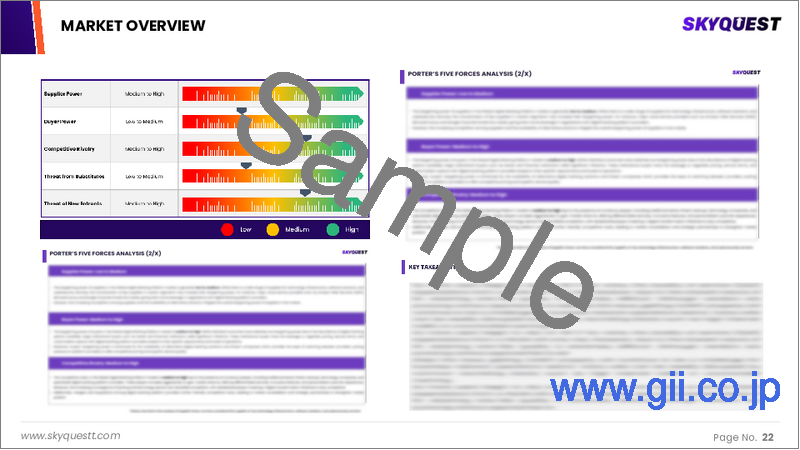|
|
市場調査レポート
商品コード
1758604
ワイヤボンダー装置の市場規模、シェア、成長分析:装置タイプ別、ボンディング技術別、最終用途産業別、ワイヤー材質別、地域別-産業予測、2025~2032年Wire Bonder Equipment Market Size, Share, and Growth Analysis, By Equipment Type (Ball Bonder, Flip Chip Bonder), By Bonding Technology (Thermocompression, Thermosonic), By End-User Industry, By Wire Material, By Region - Industry Forecast 2025-2032 |
||||||
|
|||||||
| ワイヤボンダー装置の市場規模、シェア、成長分析:装置タイプ別、ボンディング技術別、最終用途産業別、ワイヤー材質別、地域別-産業予測、2025~2032年 |
|
出版日: 2025年06月20日
発行: SkyQuest
ページ情報: 英文 193 Pages
納期: 3~5営業日
|
全表示
- 概要
- 目次
世界のワイヤーボンダー装置の市場規模は2023年に12億米ドルとなり、2024年の13億2,000万米ドルから2032年には27億4,000万米ドルに拡大し、予測期間(2025~2032年)のCAGRは9.6%で成長する見通しです。
ワイヤーボンダー装置市場は、半導体と家電機器の需要増加、自動車用電子機器の採用増加、産業自動化の台頭により、大きく拡大する見通しです。ワイヤーボンディング技術の進歩や、半導体組立・検査(OSAT)サービスのアウトソーシングニーズは、特にメーカーがコスト効率の高いソリューションを求める中で、その魅力をさらに高めています。最新の自動車へのエレクトロニクスの統合、IoTデバイスとインダストリー4.0技術の成長は、ワイヤーボンディング装置の売上を促進するさらなる触媒です。特にアジア太平洋地域のOSAT企業は、この需要に対応するために急成長していますが、先進包装技術との競合、サプライチェーンの不安定性、メンテナンスコストなどの課題は、長期的には市場の成長を妨げる可能性があります。
目次
イントロダクション
- 調査の目的
- 調査範囲
- 定義
調査手法
- 情報調達
- 二次・一次データの方法
- 市場規模予測
- 市場の前提条件と制限
エグゼクティブサマリー
- 世界市場の展望
- 供給と需要の動向分析
- セグメント別機会分析
市場力学と展望
- 市場概要
- 市場規模
- 市場力学
- 促進要因と機会
- 抑制要因と課題
- ポーターの分析
主な市場の考察
- 重要成功要因
- 競合の程度
- 主な投資機会
- 市場エコシステム
- 市場の魅力指数(2024年)
- PESTEL分析
- マクロ経済指標
- バリューチェーン分析
- 価格分析
- ケーススタディ
ワイヤーボンダー装置市場規模:装置タイプ別、CAGR(2025~2032年)
- 市場概要
- ボールボンダー
- フリップチップボンダー
- ウェッジボンダー
ワイヤーボンダー装置市場規模:ボンディング技術別、CAGR(2025~2032年)
- 市場概要
- 熱圧縮
- サーマルモード
- 高温
- 低温
- サーモソニック
- サーマルモード
- 高温
- 低温
- 超音波
- サーマルモード
- 高温
- 低温
ワイヤーボンダー装置市場規模:最終用途産業別、CAGR(2025~2032年)
- 市場概要
- 航空宇宙・防衛
- 自動車用電子機器
- 家電
- 産業用電子機器
- 通信
ワイヤーボンダー装置市場規模:ワイヤー材質別、CAGR(2025~2032年)
- 市場概要
- アルミニウム
- 銅
- 金
ワイヤーボンダー装置市場規模:地域別、CAGR(2025~2032年)
- 北米
- 米国
- カナダ
- 欧州
- ドイツ
- スペイン
- フランス
- 英国
- イタリア
- その他欧州地域
- アジア太平洋地域
- 中国
- インド
- 日本
- 韓国
- その他アジア太平洋地域
- ラテンアメリカ
- ブラジル
- その他ラテンアメリカ地域
- 中東・アフリカ
- GCC諸国
- 南アフリカ
- その他中東・アフリカ
競合情報
- 上位5社の比較
- 主要企業の市場ポジショニング(2024年)
- 主な市場企業が採用した戦略
- 最近の市場動向
- 企業の市場シェア分析(2024年)
- 主要企業の企業プロファイル
- 企業の詳細
- 製品ポートフォリオ分析
- 企業のセグメント別シェア分析
- 収益の前年比比較(2022~2024年)
主要企業プロファイル
- ASM Pacific Technology
- Kulicke & Sofa Industries Inc.
- Palomar Technologies
- F&K Delvotec Bondetechnik
- DIAS Automation(HK)Ltd.
- F & S Bondtec Semiconductor GmbH
- Shinkawa Ltd.
- TPT Wirebonder GmbH & Co.
- West Bond Inc.
- BE Semiconductor Industries N.V.
- Hesse GmbH
- Toray Engineering
- Hybond Inc.
- Boston Micro-Components
- Guangzhou Minder-Hightech Co., Ltd.
- Shenzhen Shuangshi Technology Co., Ltd.
- Anza Technology
- Kaijo Corporation
- Mech-El Industries
- Questar Products International
結論と提言
Global Wire Bonder Equipment Market size was valued at USD 1.2 billion in 2023 and is poised to grow from USD 1.32 billion in 2024 to USD 2.74 billion by 2032, growing at a CAGR of 9.6% during the forecast period (2025-2032).
The wire bonder equipment market is set for significant expansion, driven by increasing demand for semiconductors and consumer electronics, heightened adoption of automotive electronics, and the rise of industrial automation. Advancements in wire bonding technology and the need for outsourced semiconductor assembly and testing (OSAT) services further enhance its appeal, particularly as manufacturers seek cost-effective solutions. The integration of electronics in modern vehicles and the growth of IoT devices and Industry 4.0 technologies are additional catalysts propelling sales of wire bonding equipment. While OSAT companies, especially in the Asia-Pacific region, ramp up to meet this demand, challenges such as competition from advanced packaging technologies, supply chain volatility, and maintenance costs could potentially hinder market growth in the long term.
Top-down and bottom-up approaches were used to estimate and validate the size of the Global Wire Bonder Equipment market and to estimate the size of various other dependent submarkets. The research methodology used to estimate the market size includes the following details: The key players in the market were identified through secondary research, and their market shares in the respective regions were determined through primary and secondary research. This entire procedure includes the study of the annual and financial reports of the top market players and extensive interviews for key insights from industry leaders such as CEOs, VPs, directors, and marketing executives. All percentage shares split, and breakdowns were determined using secondary sources and verified through Primary sources. All possible parameters that affect the markets covered in this research study have been accounted for, viewed in extensive detail, verified through primary research, and analyzed to get the final quantitative and qualitative data.
Global Wire Bonder Equipment Market Segments Analysis
Global Wire Bonder Equipment Market is segmented by Equipment Type, Bonding Technology, End-User Industry, Wire Material and region. Based on Equipment Type, the market is segmented into Ball Bonder, Flip Chip Bonder and Wedge Bonder. Based on Bonding Technology, the market is segmented into Thermocompression, Thermosonic and Ultrasonic. Based on End-User Industry, the market is segmented into Aerospace & Defense, Automotive Electronics, Consumer Electronics, Industrial Electronics and Telecommunications. Based on Wire Material, the market is segmented into Aluminum, Copper and Gold. Based on region, the market is segmented into North America, Europe, Asia Pacific, Latin America and Middle East & Africa.
Driver of the Global Wire Bonder Equipment Market
The global wire bonder equipment market is driven by the widespread use of wire bonding, which provides an ideal mix of performance, reliability, and affordability. Despite the rising popularity of advanced packaging methods such as flip-chip and wafer-level packaging, these alternatives come with increased capital investment and greater process complexity. Wire bonding continues to hold a leading position for devices with low to medium pin counts, including analog ICs, MEMS, power electronics, and RF components. The well-established process ecosystem and comparatively low tooling and setup costs further enhance the positive outlook for the wire bonder equipment market.
Restraints in the Global Wire Bonder Equipment Market
The Global Wire Bonder Equipment market is facing significant constraints due to the growing demand for high I/O density and fine-pitch interconnections in advanced semiconductor chips. While alternative techniques like flip-chip and bump-based technologies provide advantages such as reduced interconnect distances, diminished parasitics, and enhanced thermal efficiency, wire bonding, particularly when utilizing fine gold or copper wires, encounters inherent physical and geometric limitations. These constraints hinder its ability to scale effectively for ultra-high-performance applications, potentially impacting revenue generation for companies operating in this sector, as indicated in the current market forecasts for wire bonder equipment.
Market Trends of the Global Wire Bonder Equipment Market
The Global Wire Bonder Equipment market is witnessing a significant trend towards the transition from gold to more cost-effective wire materials such as copper, silver, and aluminum. Driven by the high price volatility of gold, manufacturers are innovating equipment with advanced features, including enhanced environmental sealing, adaptive force control, and optimized capillary designs tailored for these alternative materials. This shift not only seeks to mitigate material costs but also aims to improve bonding performance, particularly in sectors like automotive and high-reliability applications. As a result, the market is evolving to meet the demands of cost efficiency and reliability, ensuring sustained growth and development.
Table of Contents
Introduction
- Objectives of the Study
- Scope of the Report
- Definitions
Research Methodology
- Information Procurement
- Secondary & Primary Data Methods
- Market Size Estimation
- Market Assumptions & Limitations
Executive Summary
- Global Market Outlook
- Supply & Demand Trend Analysis
- Segmental Opportunity Analysis
Market Dynamics & Outlook
- Market Overview
- Market Size
- Market Dynamics
- Drivers & Opportunities
- Restraints & Challenges
- Porters Analysis
- Competitive rivalry
- Threat of substitute
- Bargaining power of buyers
- Threat of new entrants
- Bargaining power of suppliers
Key Market Insights
- Key Success Factors
- Degree of Competition
- Top Investment Pockets
- Market Ecosystem
- Market Attractiveness Index, 2024
- PESTEL Analysis
- Macro-Economic Indicators
- Value Chain Analysis
- Pricing Analysis
- Case Studies
Global Wire Bonder Equipment Market Size by Equipment Type & CAGR (2025-2032)
- Market Overview
- Ball Bonder
- Flip Chip Bonder
- Wedge Bonder
Global Wire Bonder Equipment Market Size by Bonding Technology & CAGR (2025-2032)
- Market Overview
- Thermocompression
- Thermal Mode
- High Temperature
- Low Temperature
- Thermosonic
- Thermal Mode
- High Temperature
- Low Temperature
- Ultrasonic
- Thermal Mode
- High Temperature
- Low Temperature
Global Wire Bonder Equipment Market Size by End-User Industry & CAGR (2025-2032)
- Market Overview
- Aerospace & Defense
- Automotive Electronics
- Consumer Electronics
- Industrial Electronics
- Telecommunications
Global Wire Bonder Equipment Market Size by Wire Material & CAGR (2025-2032)
- Market Overview
- Aluminum
- Copper
- Gold
Global Wire Bonder Equipment Market Size & CAGR (2025-2032)
- North America (Equipment Type, Bonding Technology, End-User Industry, Wire Material)
- US
- Canada
- Europe (Equipment Type, Bonding Technology, End-User Industry, Wire Material)
- Germany
- Spain
- France
- UK
- Italy
- Rest of Europe
- Asia Pacific (Equipment Type, Bonding Technology, End-User Industry, Wire Material)
- China
- India
- Japan
- South Korea
- Rest of Asia-Pacific
- Latin America (Equipment Type, Bonding Technology, End-User Industry, Wire Material)
- Brazil
- Rest of Latin America
- Middle East & Africa (Equipment Type, Bonding Technology, End-User Industry, Wire Material)
- GCC Countries
- South Africa
- Rest of Middle East & Africa
Competitive Intelligence
- Top 5 Player Comparison
- Market Positioning of Key Players, 2024
- Strategies Adopted by Key Market Players
- Recent Developments in the Market
- Company Market Share Analysis, 2024
- Company Profiles of All Key Players
- Company Details
- Product Portfolio Analysis
- Company's Segmental Share Analysis
- Revenue Y-O-Y Comparison (2022-2024)
Key Company Profiles
- ASM Pacific Technology
- Company Overview
- Business Segment Overview
- Financial Updates
- Key Developments
- Kulicke & Sofa Industries Inc.
- Company Overview
- Business Segment Overview
- Financial Updates
- Key Developments
- Palomar Technologies
- Company Overview
- Business Segment Overview
- Financial Updates
- Key Developments
- F&K Delvotec Bondetechnik
- Company Overview
- Business Segment Overview
- Financial Updates
- Key Developments
- DIAS Automation (HK) Ltd.
- Company Overview
- Business Segment Overview
- Financial Updates
- Key Developments
- F & S Bondtec Semiconductor GmbH
- Company Overview
- Business Segment Overview
- Financial Updates
- Key Developments
- Shinkawa Ltd.
- Company Overview
- Business Segment Overview
- Financial Updates
- Key Developments
- TPT Wirebonder GmbH & Co.
- Company Overview
- Business Segment Overview
- Financial Updates
- Key Developments
- West Bond Inc.
- Company Overview
- Business Segment Overview
- Financial Updates
- Key Developments
- BE Semiconductor Industries N.V.
- Company Overview
- Business Segment Overview
- Financial Updates
- Key Developments
- Hesse GmbH
- Company Overview
- Business Segment Overview
- Financial Updates
- Key Developments
- Toray Engineering
- Company Overview
- Business Segment Overview
- Financial Updates
- Key Developments
- Hybond Inc.
- Company Overview
- Business Segment Overview
- Financial Updates
- Key Developments
- Boston Micro-Components
- Company Overview
- Business Segment Overview
- Financial Updates
- Key Developments
- Guangzhou Minder-Hightech Co., Ltd.
- Company Overview
- Business Segment Overview
- Financial Updates
- Key Developments
- Shenzhen Shuangshi Technology Co., Ltd.
- Company Overview
- Business Segment Overview
- Financial Updates
- Key Developments
- Anza Technology
- Company Overview
- Business Segment Overview
- Financial Updates
- Key Developments
- Kaijo Corporation
- Company Overview
- Business Segment Overview
- Financial Updates
- Key Developments
- Mech-El Industries
- Company Overview
- Business Segment Overview
- Financial Updates
- Key Developments
- Questar Products International
- Company Overview
- Business Segment Overview
- Financial Updates
- Key Developments





